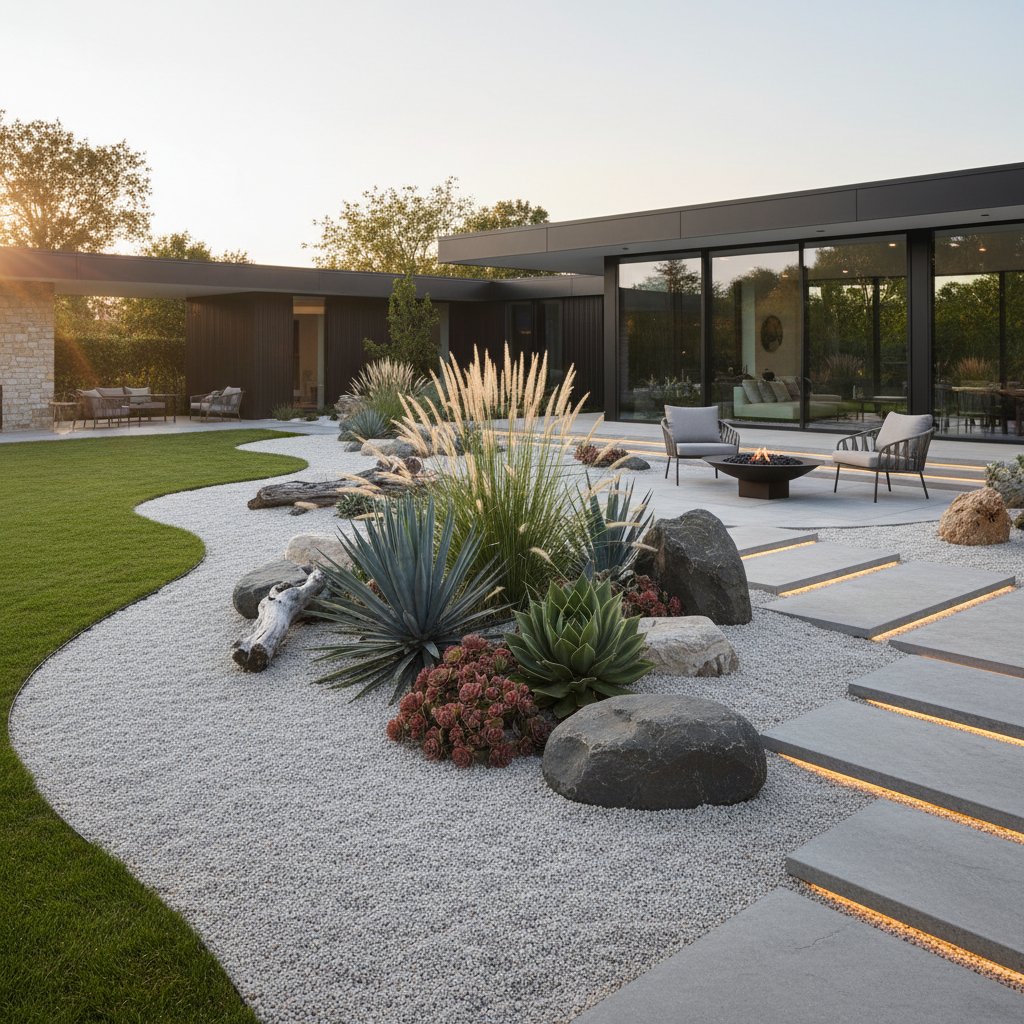Gravel Gardens: Budget-Friendly Refinement for 2025 Landscapes
Gravel gardens emerge as an intelligent choice for crafting sophisticated outdoor areas that demand little effort compared to conventional lawns. These designs strike an ideal balance between aesthetic appeal and practical upkeep. Homeowners seeking to revitalize a modest side yard or overhaul a full front entrance will find gravel gardens provide economical solutions, robust longevity, and adaptable aesthetics suited to diverse preferences.
Defining a Gravel Garden
A gravel garden consists of ornamental stones, water-efficient plants, and subtle hardscape elements that replace turf or thick vegetation. Gravel serves as the primary ground cover, allowing swift water drainage, discouraging weed proliferation, and requiring sparse attention throughout the seasons.
Typical plant selections draw from native species or Mediterranean varieties, including lavender, sage, ornamental grasses, and succulents. The resulting aesthetic conveys a casual yet deliberate naturalness. Property owners can incorporate winding pathways, designated seating zones, or focal points around structures by varying gravel sizes and hues.
Reasons Homeowners Opt for Gravel Gardens
Cost savings drive much of the appeal. Traditional lawns necessitate regular irrigation, mowing, and nutrient applications, accumulating significant expenses annually. Gravel gardens substantially lower these outlays; post-installation care involves periodic raking, selective weeding, and routine seasonal tidying.
Design versatility represents another key advantage. Gravel adapts seamlessly to multiple architectural motifs, complementing sleek modern residences with their straight edges as readily as it enhances pastoral or quaint cottage settings. Integrate it alongside pavers, stone borders, or aged timber to introduce contrasting textures and visual interest.
Sustainability further bolsters its popularity. These gardens conserve water, addressing shortages prevalent in numerous areas. Planting with nectar-rich varieties supports essential pollinators like bees and butterflies, fostering biodiversity.
Analyzing Costs and Installation
Establishing a gravel garden ranks among the more economical landscaping endeavors. Basic gravel ranges from one to three dollars per square foot, influenced by variety and shade. Premium decorative aggregates, offering enhanced visual depth, typically cost three to six dollars per square foot.
Installation expenses vary with yard dimensions and existing conditions. Removing sod incurs additional preparation fees. Professional services generally total five to ten dollars per square foot, encompassing labor and supplies. Self-directed projects can halve these figures, provided meticulous preparation occurs.
Consider this breakdown for a 200-square-foot gravel garden:
- Gravel or decorative stone: 200 to 600 dollars
- Landscape fabric and edging: 50 to 150 dollars
- Plants and mulch: 100 to 300 dollars
- Optional features (boulders, pavers, lighting): 100 to 400 dollars
Overall, such a project falls between 450 and 1,450 dollars, adjustable based on selections and complexities.
Selecting Appropriate Gravel
Available gravel varieties differ in form, dimension, and pigmentation. Pea gravel, with its rounded, foot-friendly pebbles, suits pathways and lounging spots effectively. Crushed stone, featuring angular fragments, interlocks securely to minimize displacement.
Decomposed granite yields a powdery, stabilized layer resembling packed earth. Evaluate intended functions when choosing: opt for quarter-inch rounded pebbles in high-traffic zones for comfort. Finer particles excel in planting surrounds, resisting migration. Harmonize colors with home facades; neutral beige or tan enhances brick and plaster finishes, whereas slate or ebony tones align with contemporary concrete and metal elements.
To source materials, visit local suppliers for samples. Test compatibility by spreading small amounts in your yard to assess drainage and appearance under natural light.
Inspiring Design Concepts for Gravel Gardens
Tailor a gravel garden to range from understated to elaborate. Begin by sketching functional areas for vegetation, relaxation, or circulation. Employ borders such as metal strips, rock outlines, or lumber frames to delineate spaces and secure the gravel.
Explore these concepts:
- Contemporary Minimalism: Employ sleek gray gravel paired with precise stone pavers and feathery grasses. Incorporate statement succulents like agave or yucca for striking, uncluttered impact.
- Quaint Cottage Charm: Blend pastel gravel with flowering perennials including lavender, catmint, and yarrow. Curve a meandering trail and position a timber seat to evoke warmth and invitation.
- Mediterranean Vibes: Select sun-warmed gravel alongside resilient herbs such as rosemary and thyme. Scatter clay pots to evoke a laid-back, arid ambiance.
- Serene Zen Escape: Pair light gravel with broad slabs, compact shrubs, and a modest fountain. Limit foliage to promote tranquility and introspection.
Gravel's impartial base elevates surrounding flora and materials, ensuring each element shines.
Upkeep and Sustained Management
While gravel gardens demand minimal intervention, consistent practices preserve their allure. Rake periodically to level the surface and clear foliage or litter. Utilize a low-powered blower to disperse fine debris without scattering stones.
Monitor for weeds emerging at perimeters or fabric gaps; extract them promptly to prevent establishment. Gravel may compact or disperse over years; replenish with a shallow layer biennially for renewed vibrancy. In rainy climates, verify drainage to avoid accumulation in depressions.
Established plants flourish with infrequent hydration. Administer thorough soaks biweekly during arid periods. Trim spent portions annually to maintain neatness and encourage vitality.
Schedule an annual inspection: assess edging integrity, refresh plant health, and adjust gravel depth as needed. These steps ensure longevity without overwhelming effort.
Steps to Implement Your Gravel Garden
Commence modestly by repurposing a narrow border, secluded patio edge, or neglected planting zone. Observe the reduced demands relative to turf or lush beds firsthand.
Draft a site plan, procure gravel attuned to your residence, and choose resilient species matching local conditions. Engage a regional expert for flawless execution if precision matters. The outcome yields an upscale, organic landscape with diminished upkeep burdens.
Beyond aesthetics, a gravel garden liberates time from irrigation and clipping routines, instilling tranquility upon each visit. Through deliberate design and ingenuity, achieve opulent outdoor living within financial reach.



